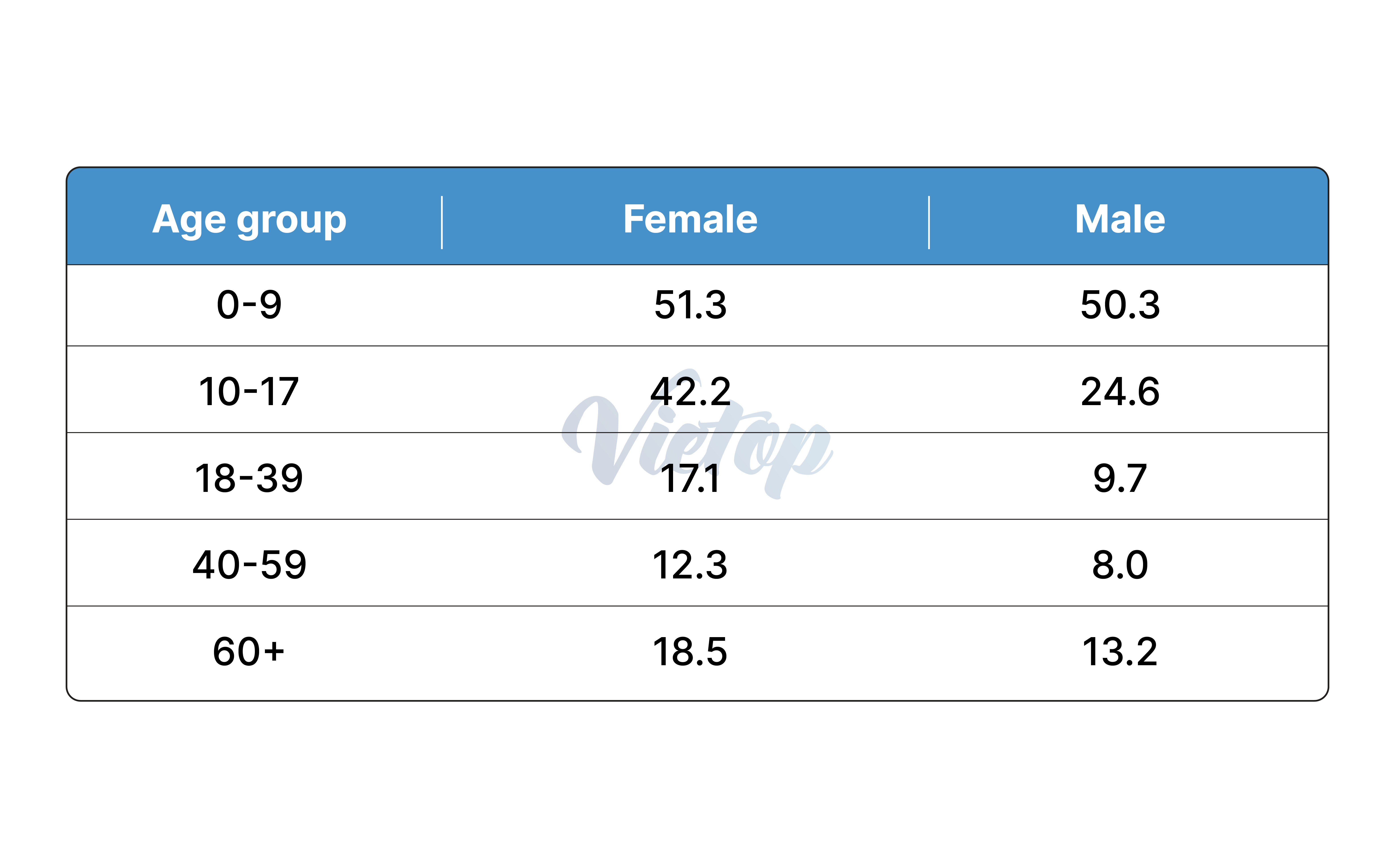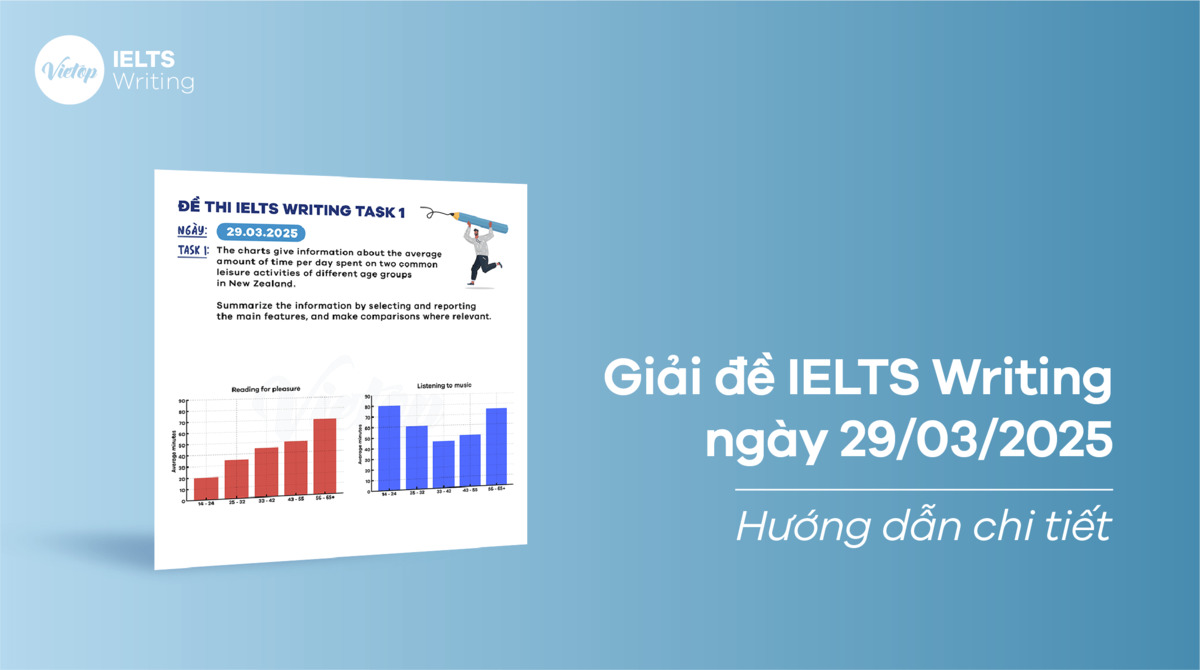Vietop gửi bạn giải đề IELTS Writing ngày 12/08/2023 bên dưới nhé! Các bạn theo dõi và ôn luyện IELTS Writing thật tốt nhé!
IELTS Writing task 1
TASK 1. The table below shows the percentage of the population by age groups in one town who rode bicycles in 2011.

Bước 1: Lập dàn ý
Đoạn tổng quan:
- Tổng số nam tham gia vượt trội so với nữ ở tất cả các nhóm tuổi, tỷ lệ tham gia cao nhất của cả hai giới được ghi nhận ở nhóm tuổi dưới 9.
- Tuy tỷ lệ giảm đáng kể theo độ tuổi, nhưng có dấu hiệu đảo ngược xu hướng này ở nhóm tuổi cao nhất.
Thân bài 1:
- Nhóm tuổi tham gia đông đảo nhất là nhóm tuổi dưới 9, với 51.3% nữ và 50.3% nam tham gia hoạt động này.
- Từ độ tuổi 10 đến 17, số lượng người tham gia giảm đi và chênh lệch đáng kể khoảng 20% giữa nam và nữ, lần lượt là 42.2% và 24.6%
Thân bài 2:
- Với các nhóm tuổi cao hơn, người tham gia đạp xe ít hơn so với những người trẻ hơn.
- Tỷ lệ nam tham gia hoạt động này ở độ tuổi trên 60 (18.5%) vượt qua con số tương ứng cho nam ở độ tuổi 18-39 (17.1%) và 40-59 (12.3%).
- Một khuynh hướng tương tự được thấy ở phái nữ, tỷ lệ tham gia ở nhóm tuổi cao nhất chiếm 13.2%, so với 9.7% và 8% ở nhóm tuổi 18-39 và 40-59 tương ứng.
Bước 2: Hoàn thành bài luận
The table gives information about the percentage of men and women of different ages who engaged in a bicycle-riding activity in a specific town in the year 2011. Overall, in all age groups, males outnumbered women in riding bicycles, with the highest participation rates of both genders being recorded in the age group under 9. In addition, the figures decreased significantly with age, although there was evidence of this trend reversing in the oldest age category.
Regarding age groups with a larger proportion of participants, the youngest age group was the dominant one, with 51.3% of the 0- to 9-year-old females taking part in this activity compared to 50.3% of males. However, from the age of 10 to 17 onwards, the numbers saw a decline, and a significant difference of approximately 20% was witnessed in the percentages of males and females who participated in a bike ride, which were 42.2% and 24.6% respectively.
In terms of the remaining older age groups, the older participants generally rode bicycles less than their younger counterparts. The percentage of males aged over 60 who engaged in this activity (18.5%) overtook the corresponding figures for men aged 18-39 (17.1%) and 40-59 (12.3%). A similar pattern was seen in the opposite gender, whose participation rate in the oldest age bracket accounted for 13.2%, as opposed to 9.7% and 8% of women who fell into the age groups of 18-39 and 40-59 respectively.
Bạn gặp khó khăn trong việc phân tích và trình bày số liệu để đạt IELTS 7.0? Khóa học IELTS 7.0 tại Vietop sẽ là lựa chọn phù hợp giúp bạn nắm vững chiến lược phân tích và viết cho cả Writing Task 1 và Task 2. Tham khảo ngay khoá học chi tiết để đạt band điểm IELTS mục tiêu.
Bước 3: Từ vựng
| Vocabulary/Collocations | Meaning (in Vietnamese) |
| Engaged in | Tham gia vào |
| Outnumbered | Đông hơn |
| Participation rates | Tỷ lệ tham gia |
| Reverse | Đảo ngược lại |
| Corresponding figures | Dữ liệu tương ứng |
Please fill in the blanks using the words/ phrases above
The (1) __________ of men and women in the bicycle-riding activity varied across different age groups in the town of 2011. Males (2) __________ females in almost every age group. The (3) __________ were highest among individuals under 9 years old. Interestingly, this trend seemed to (4) __________ in the oldest age category.
Regarding the age groups with a larger proportion of participants, the youngest age group had the highest (5)__________. For example, 51.3% of females aged 0 to 9 were actively (6)__________ in this activity, compared to 50.3% of males in the same age group. However, as participants aged from 10 to 17, these numbers decreased. There was a notable difference of about 20% between the (7)__________ for males and females in this age range.
ANSWER:
- 1. Participation rates
- 2. Outnumbered
- 3. Participation rates
- 4. Reverse
- 5. Participation rates
- 6. Engaged in
- 7. Corresponding figures
Bước 4: Cấu trúc ngữ pháp
- Regarding để mở đầu một phần: Từ “Regarding” được dùng để giới thiệu một phần cụ thể trong bài viết, như là một dấu hiệu cho người đọc biết chúng ta sẽ nói về cái gì ở phần tiếp theo.
- In terms of để giới thiệu khía cạnh: Cụm từ này giới thiệu các khía cạnh khác nhau mà bài viết sẽ đề cập.
- Sử dụng cấu trúc with để mô tả ngữ cảnh: Cấu trúc “with” được sử dụng để mô tả ngữ cảnh của các số liệu trong bảng.
- Cấu trúc so sánh “as opposed to”: Cấu trúc này được sử dụng để so sánh hai điểm đối lập với nhau
Xem thêm:
- Giải đề IELTS Writing ngày 05/08/2023
- Giải đề IELTS Writing ngày 29/07/2023
- Giải đề IELTS Writing ngày 22/07/2023
IELTS Writing task 2
TASK 2. The best way to reduce poverty in developing countries is by giving up to six years of free education, so that they can at least read, write and use numbers. To what extent do you agree or disagree?
Bước 1: Phân tích đề
- Từ khoá: best way, reduce poverty, six years of free education
- Câu hỏi: Đây là dạng Opinion Essay, yêu cầu người viết cần đưa ra quan điểm của mình về việc bạn đồng ý hay không đồng ý với nhận định được đưa ra. Ở đây Vietop sẽ theo hướng phản đối nhiều hơn so với đồng tình (70-30).
Bước 2: Lập kế hoạch cho bài luận
Ý chính: Nhấn mạnh rằng giáo dục là bước quan trọng, nhưng cần có cách tiếp cận toàn diện để giải quyết nghèo.
| Thân bài 1 Lợi ích của giáo dục trong việc giảm nghèo: | Thân bài 2 Giáo dục không đủ để giải quyết nghèo. |
| Ý chính 1: Đào tạo nghề giúp mở cơ hội việc làm. Ý chính 2: Lực lượng lao động trình độ cao góp phần bền vững kinh tế. Ý chính 3: Giáo dục tạo quyền lực cho phụ nữ và các nhóm bị cách biệt. | Ý chính 1: Đảm bảo cơ bản trước: nhà ở, thức ăn và chăm sóc sức khỏe. Ý chính 2: Chất lượng giáo dục cần cải thiện. Ý chính 3: Hợp tác quốc tế cần thiết để đảm bảo giáo dục miễn phí. |
Bước 3: Hoàn thành bài luận
Sample Essay 1 (Band 6.0)
Providing free education for up to six years is believed to be an effective way to alleviate poverty in developing nations. This approach has its merits, but it may not be the ultimate solution to address the serious issue of poverty.
Education has the potential to help reduce poverty. By offering vocational training, people can acquire skills needed for better job prospects. A well-educated workforce can contribute to a country’s economy and break the cycle of poverty. Education is also important for empowering marginalized groups, like women, who lack access to education. With education, they can improve not only their literacy skills but also critical thinking and leadership abilities, enabling them to participate in society and voice their opinions.
However, offering education alone might not fully solve poverty. Basic necessities like shelter, food, and healthcare are fundamental before educational opportunities can be effective. Without these, individuals cannot engage in learning effectively. Moreover, the quality of education matters. Rote memorization should be avoided in favor of practical skills and soft skills. Also, funding free education is a significant challenge that requires international cooperation and assistance.
While providing free education is an important step, it may not be the sole solution for poverty in developing nations. Addressing poverty requires considering basic needs, improving education quality, and collaborating with developed countries. In essence, a comprehensive approach is necessary to effectively combat poverty.
Sample Essay (Band 8.0)
It is thought that in order for poverty in developing countries to be alleviated, a free provision of 6-year education to equip citizens with basic literacy and numeracy skills is the most effective method. While this approach can work to a certain extent, it is by no means the best solution there is to deal with the alarming issue of poverty.
On the one hand, there are sound reasons to argue that education can contribute to the mitigation of impoverishment. This firstly stems from the fact that educational initiatives, especially those in the form of vocational training, can equip individuals with necessary skills and knowledge to get access to better employment opportunities. A well-educated workforce would, in turn, contribute to the economic sustainability of a country, and is likely to break the poverty cycle as a result.
Another explanation is that education has an important role to play in empowering individuals, especially women and groups being marginalized by discriminatory practices, who cannot escape from poverty due to lack of access to education. With education, they can enhance not only their ability to read and write, but also sharpen their critical thinking, leadership and decision-making skills, all of which potentially allow the underprivileged the power to take up space in society, the ability to voice their opinions, and eventually would be able to improve their country’s state of well-being.
On the other hand, I am of the opinion that offering education alone cannot tackle the problem of poverty holistically, and there are several more important factors to be taken into account. To begin with, basic human necessities, including shelter, food and healthcare must be guaranteed first before any considerations can be given to educational opportunities. Without having access to these immediate needs, individuals cannot fully engage in education and the benefits of the proposal can be limited.
Additionally, besides widespread accessibility, the quality of education cannot pale into insignificance. Education should stay away from rote memorization, like what has long been observed in the education system in many developing countries. Instead, such a system should ensure the teaching of relevant job-related skills, crucial soft skills and promote the empowerment of an individual. Finally, free education is a massive undertaking that cannot be carried out just by the domestic government. In other words, cooperation from developed countries and international aid are essential for comprehensively addressing the issue of poverty.
In conclusion, while it is understandable why offering free education is an essential first step, it might not be the only way to combat poverty in developing nations. Tackling poverty is a complex issue which requires the offer of basic human needs, the quality of education offered and the collaboration of advanced countries.
Bước 4: Từ vựng
| Vocabulary/Collocations | Meaning (Vietnamese) |
| Alleviated | Giảm nhẹ, làm dịu đi |
| Mitigation | Sự giảm nhẹ, làm dịu |
| Impoverishment | Sự nghèo khó |
| Vocational training | Đào tạo nghề |
| Marginalized | Bị cách biệt, bị xem thường |
| Empowerment | Sự cấp quyền, trao quyền |
| Sustainability | Sự bền vững |
| Holistically | Toàn diện, tổng thể |
| Rote memorization | Học vẹt, học thuộc lòng |
Fill in the blanks with the appropriate words/phrases in the box.
- The government’s efforts to provide free education have significantly __________ the poverty rates in rural areas.
- Environmental __________ measures are crucial to reduce the impact of industrial activities on the ecosystem.
- The community development program aims to address the __________ experienced by families living in extreme poverty.
- Many young adults are enrolling in __________ programs to gain practical skills that enhance their job prospects.
- People belonging to minority groups often feel __________ and excluded from mainstream opportunities.
- The organization focuses on the __________ of women through education and entrepreneurship training.
- Implementing renewable energy sources is vital for the __________ of our planet’s resources for future generations.
- To address complex health issues, healthcare professionals need to consider patients’ well-being __________, including mental and physical aspects.
- The educational system should prioritize critical thinking over __________, as it encourages deeper understanding of subjects.
ANSWERS:
- Alleviated
- Mitigation
- Impoverishment
- Vocational training
- Marginalized
- Empowerment
- Sustainability
- Holistically
- Rote memorization
Bước 5: Cấu trúc ngữ pháp
- 1. It is believed/thought/said that…: Mẫu câu này dùng để giới thiệu quan điểm mà người viết đang trình bày.
- 2. Từ “all of which” là một cụm từ được sử dụng để chỉ tập hợp các vật/thứ đã được đề cập trước đó. Trong câu bạn cung cấp:
“With education, they can enhance not only their ability to read and write, but also sharpen their critical thinking, leadership, and decision-making skills, all of which potentially allow the underprivileged the power to take up space in society, the ability to voice their opinions, and eventually would be able to improve their country’s state of well-being.”
Trong ngữ cảnh này, “all of which” đề cập đến những kỹ năng đã được đề cập trước trong câu (“khả năng đọc và viết, tư duy phản biện, khả năng lãnh đạo và quyết định”). Nó nhấn mạnh rằng mỗi kỹ năng này đóng góp vào việc tự quyền cho những người bị cách biệt. Cụm từ “all of which” hoạt động như một cách ngắn gọn để tránh lặp lại danh sách các kỹ năng và cung cấp cách ngắn gọn để cho biết rằng mỗi kỹ năng này đóng vai trò trong việc đạt được các kết quả được đề cập sau đó.
Xem ngay: Tổng hợp đề thi IELTS Writing 2023 kèm bài mẫu chi tiết
Hy vọng bài giải đề IELTS Writing ngày 12/08/2023 đã cung cấp thêm cho bạn nhiều từ vựng, cấu trúc và ý tưởng để vận dụng cho bài viết của mình khi luyện thi IELTS. Chúc bạn thi IELTS tốt!
Ngoài ra, các bạn cần phải thường xuyên cập nhập lịch thi IELTS để có kế hoạch ôn thi IELTS phù hợp nhé!


![[ACE THE TEST] Giải đề IELTS Writing ngày 07/04/2025](https://vietop.edu.vn/wp-content/uploads/2025/04/giai-de-ielts-writing-ngay-07-04-2025.png)

![[ACE THE TEST] Giải đề IELTS Writing ngày 15/03/2025](https://vietop.edu.vn/wp-content/uploads/2025/03/giai-de-ielts-writing-ngay-15-03-2025.jpg)
![[ACE THE TEST] Giải đề IELTS Writing ngày 22/03/2025](https://vietop.edu.vn/wp-content/uploads/2025/03/giai-de-ielts-writing-ngay-22-03-2025.jpg)
![[ACE THE TEST] Giải đề IELTS Writing ngày 08/03/2025](https://vietop.edu.vn/wp-content/uploads/2025/03/giai-de-ielts-writing-ngay-08-03-2025.jpg)
![[ACE THE TEST] Giải đề IELTS Writing ngày 06/03/2025](https://vietop.edu.vn/wp-content/uploads/2025/03/giai-de-ielts-writing-ngay-06-03-2025.jpg)
![[ACE THE TEST] Giải đề IELTS Writing ngày 22/02/2025](https://vietop.edu.vn/wp-content/uploads/2025/02/giai-de-ielts-writing-ngay-22-02-2025.jpg)
